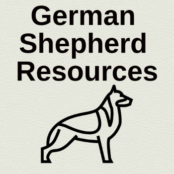Raising a German Shepherd puppy can be one of the most rewarding experiences for any pet owner. The German Shepherd breed is known for its intelligence, loyalty, and versatility, but it also requires dedicated care and training. In this comprehensive guide, we walk through the first year of German Shepherd puppy growth and development from the day you bring them home to their first steps into adulthood.
Table of Contents
Month 1: Beginning to Explore
Physical Changes
Your German Shepherd puppy is a tiny ball of fluff at this age weighing between 8-10 pound. His eyes are now open and he can now hear. From this point your puppies growth will be phenomenally fast. You will swear you can see him growing daily.
Behavioral Changes
At this stage, your puppy is experiencing new sights, smells, and sounds as they adjust to their new environment. They may be timid at first, but will quickly grow curious and begin to explore. The first month is also crucial for bonding with mother and litter mates. The mother will begin to wean and this will be complete around 6 weeks.
Training and Care
At this point your puppy should still be with its mother and siblings. He has many important things to learn from his sibling interaction. A reputable breeder will not let you take the puppy home before 8 weeks.
Month 2: The Formative Period
Physical Changes
Rapid growth continues as your puppy doubles in size and sprouts longer limbs. They’ll also continue teething, which means they’ll want to chew—on everything. Provide appropriate chew toys and discourage biting inappropriate items. He is now 8 weeks old and ready to come to his new home. His weight is now around 20 pounds.
Behavioral Changes
Your puppy is learning more about their environment and will continue to explore. They may also start testing boundaries and asserting dominance, so it’s important to establish yourself as the pack leader through consistent training and socialization.
Playtime intensifies in the second month, as your pup becomes more agile and interactive. This is the time they start learning social cues from both dogs and humans. Ensure playtime is not too rough, as they are still learning their strength.
Training and Care
Begin introducing simple commands such as ‘sit’ and ‘come.’ Focus on positive reinforcement and short, engaging training sessions. Luring works very well. In luring you simply use the treat to “lure” your puppy into a position such as sit. You don’ even use the word to begin with. Potty training is in full swing, with frequent trips outside and rewards for successful bathroom breaks.
Month 3: Socialization and Learning
Physical Changes
Height and weight gain continue, with the puppy’s coordination improving significantly. Their adult teeth begin to gradually replace the milk teeth. Make sure he has teething toys and substitute them when he tried to use your fingers! You puppy may now weigh around 25-30 pounds.
Behavioral Changes
Your puppy’s social world expands as they become more adept at interacting with their environment. Their curiosity and playfulness know no bounds, but be alert for the beginning of potential fear periods, when they may become more sensitive to new experiences.
Training and Care
Dedicate time to structured socialization. Introduce them to various environments, dogs, and people. (Dogs only after they are immunized) Basic training should include ‘stay’ and ‘down’, and continue reinforcing the commands learned in month two. Continue crate training and make sure to leave them with lots of stimulating chew toys when crated.
Month 4 to 6: Adolescence Begins
Physical and Behavioral Milestones
The growth rate begins to slow down in the fourth month, and your puppy’s adult coat starts to come in. You may notice their ears starting to stand up if they haven’t already. At around six months, they have a significant growth spurt and will look more like a miniature version of their adult selves. your puppy may weigh around 40-50 pounds at this stage.
Sexual Maturity
At around six months, your puppy will reach sexual maturity and begin to show signs of being ready to mate. Large breed such as German Shepherds should not be “fixed” until they reach at least 18 months as it is believed to interfere with bone growth and density.
In terms of behavior, you’ll see more independence and a testing of boundaries. This is a critical juncture for training; consistency and patience are key.
Training and Care
Use this time to reinforce basic obedience and socialization. Increase training sessions to challenge your GSD’s growing intellect. Use positive reinforcement, as they can be sensitive and react well to praise. Channel their energy into physical activities like running and playing to avoid destructive behavior. Remember every interaction with your puppy IS training. You have to have rules and follow through.
Month 7 to 9: Continuing Development
Physical Changes
Your GSD will reach near-adult size, and they might go through a coat change, referred to as “blowing coat”. This can lead to a significant increase in shedding as the puppy trades in their soft fluff for the classic dense double coat of an adult German Shepherd. You puppy probably weighs around 60-70 pounds at this stage.
Mental Development
Your puppy’s mental and physical development will continue at a rapid pace. They’ll experience many “fear periods” where they may become suddenly afraid of things that were previously fine, or even act out aggressively. This is normal behavior and requires patience and positive reinforcement to work through.
Behavioral Changes
Mentally, they’ll be more mature and their social behavior more refined. This is the time to build on any fears they develop during the fear period, using positive reinforcement. They’ll still have bouts of energy, but it will be less wild and more controlled than before.
Training and Care
Take advantage of their increased attention span and maturing body by introducing them to more advanced training activities. They will be more reliable with their commands, but it’s essential to keep training consistent. If you are experiencing issues now’s the time to seek professional help if needed.
Month 10 to 12: Approaching Adulthood
Physical Changes
Towards the end of their first year, your GSD will be close to their adult size and may even start filling out with muscle. They’ll be strong and agile, with much of the puppy clumsiness fading away. Keep in mind German Shepherds continue to put on muscle to 2-3 years and will not have reached full size before then though their height has probably been reached by now.
Behavioral Changes
By the end of the first year, your GSD’s temperament will start to stabilize, and they’ll have a clearer understanding of their place within the family pack. At this point, they are truly ready to advance into more complex training and tasks. If you pup has not totally settled down keep in mind it takes larger breeds longer to mature.
Training and Care
Continue with regular exercise and training to maintain the connection with your pup and keep them mentally stimulated. This is a crucial period for establishing the behaviors you want to see in your adult dog. You are setting the foundation for years to come.
Final Thoughts
The first year with your German Shepherd puppy is a whirlwind of growth, learning, and bonding. Each month brings new challenges and milestones as you work together to build the foundation for a strong and harmonious relationship. I encourage you to take frequent pictures as they grow so fast!
Looking beyond the puppy months, continue to invest in your dog’s development. Mental and physical activity are vital to a German Shepherd’s well-being, and training should be a lifelong commitment. Remember, a well-trained dog is a happy dog, and a happy dog is a joy to have in your life.
Enjoy the process of raising your German Shepherd puppy, month by month, and look forward to many years of loyal companionship and adventure with your now not-so-little four-legged friend.

